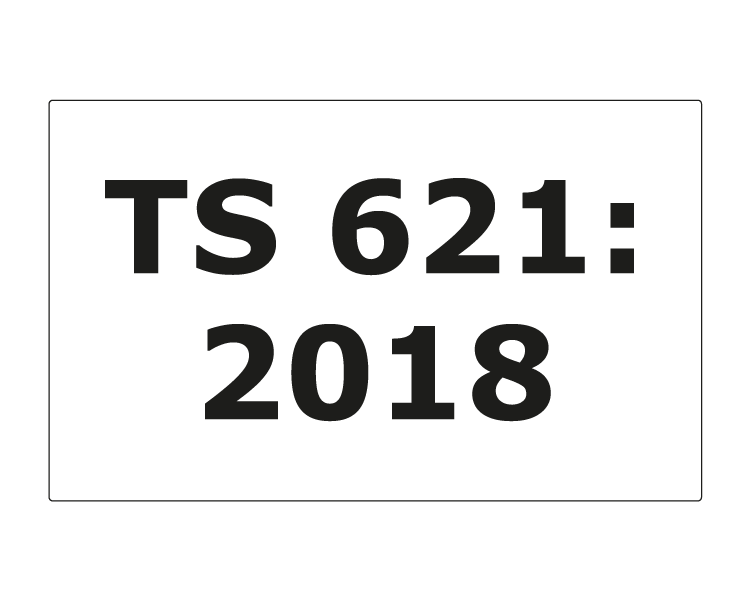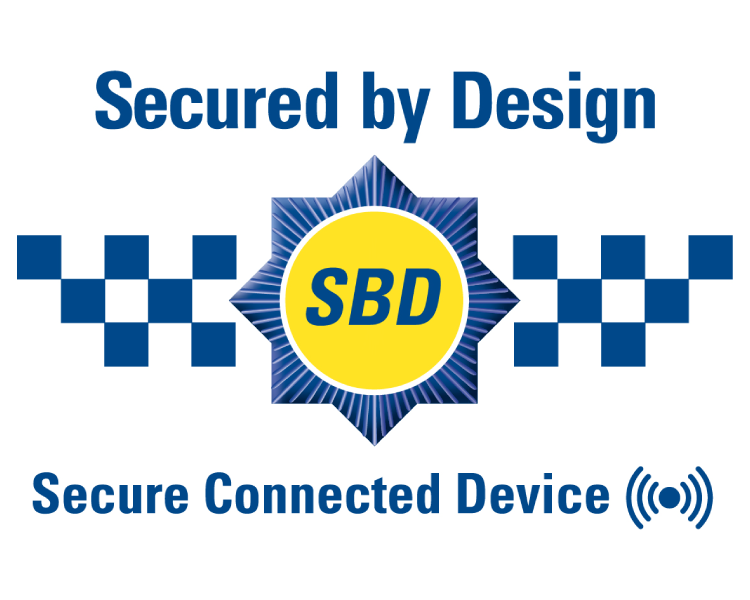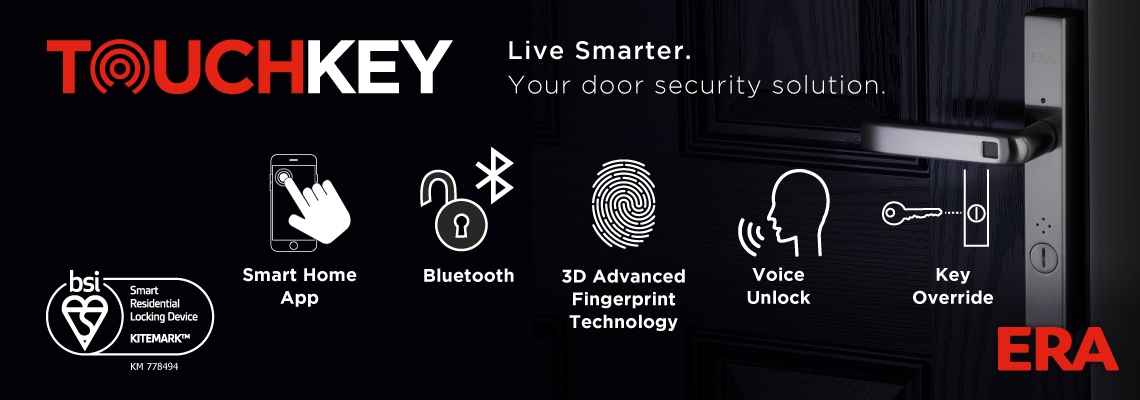Smart Locking Standards
The ERA TouchKey door solution has been independently tested and kitemarked to the BSI Smart Residential Locking Device standard. This incorporates a couple of other standards you may or may not be familiar with. It has also been awarded the Secure Connected Device accreditation. Here we explain in further detail each standard, its relevance and how ERA can help:
- BSI Smart Residential Locking Device Kitemark
- BSI IoT Kitemark
- TS 621
- Secure Connected Device
- How can ERA help?
What is a BSI Smart Residential Locking Device Kitemark?
The BSI in conjunction with ERA has recently introduced and developed a kitemark solely focused on smart locking devices used to secure and operate residential doors.
Previously there were two separate standards available for smart locks - the BSI IoT Kitemark (for smart security devices) and TS 621 (the technical standard for mechanical security devices with smart locking). This new Smart Residential Locking Device Kitemark combines these two standards into one and sets the stall out for how we should view and assess smart locking devices moving forwards.


Smart security: BSI IoT Kitemark

Mechanical security with smart locking: TS 621
What is a BSI Internet of Things (IoT) Kitemark?
The BSI introduced a kitemark focused on IoT products, due to the growing number of connected products, and the spread of these now available for consumers. The rise of such devices means the rules and regulations around data transfer, security and functionality need to be more stringent. The idea of this Kitemark is to mark those products that have passed the set of rigorous tests to make it easier for consumers to recognise and make an informed choice. Devices with the IoT Kitemark can then be visibly seen by a consumer as trustworthy, safe, and secure.
What is the Internet of things (IoT)?
The Internet of Things (IoT) is a network of connected smart devices, people, and systems, enabling data to be exchanged between devices over the internet to allow everyday objects/tasks to be made more efficient. Either connected to each other in some way e.g., Bluetooth connected devices or to the wider internet, an app or the cloud. It includes lots of recognisable smart devices, from mobile phones to fridges, door locks, alarms, and lighting.
The complexity of IoT and how such devices are connected poses lots of questions about data storage, data transfer and encryption. This may make it difficult for a consumer to understand new products and services and trust the devices and their data connections.
What is the BSI Kitemark for IoT Devices?
Products awarded a BSI IoT Kitemark must undergo initial and ongoing rigorous and independent assessments to make sure the device both functions and communicates as it should and that it has the appropriate security controls in place. This includes achieving and maintaining conformity to ISO 9001 (Quality management system) and ensuring the product/ solution has passed the relevant product performance and safety tests, interoperability tests, penetration tests etc.

Smart security: BSI IoT Kitemark
What is TS 621?
TS 621:2018 is a technical standard from the Door and Hardware Federation (DHF) in response to a market requirement for third party certification of residential thief resistant electronic door locking devices. It brings together many other BS, PAS and TS standards together to ensure a robust set of classifications that the overall TS 621 solution should conform to. See the full standard for more details, a summary is below.
The scope includes the ock and lock interface, credentials, the vulnerability of radio frequency network (resistance to attack through manipulation of a credential sent from an active device) and vulnerability of device (attempts to render the device insecure using knowledge and skill, using manual dexterity and manipulative skills, rather than excessive force).
The specification covers electronic door locking devices that are used on doors, window doors and entrance doors in residential and similar buildings. The test is carried out by an official MLA Locksmith who will attack the electro-mechanical part of the smart lock to ensure that the security of the lock is not comprised.

Mechanical security with smart locking: TS 621

Secure Connected Device
What is a Secure Connected Device?
With the Government soon introducing the Product Security and Telecommunications Infrastructure (PSTI) Bill, which includes three principles of the CoP and coupled with a growing demand from the industry, SBD launched a new 'Secure Connected Device' accreditation scheme. This is for companies providing IoT connected products and services to demonstrate that their products have achieved the appropriate and relevant IoT standards and certifications from an SBD recognised certification body.
Working closely with certification bodies who assess IoT products and services against all 13 provisions of the ETSI EN 303 645 standard, the SBD IoT device assessment, identifies the level of risk associated with an IoT device and its ecosystem, providing recommendations on the appropriate certification routes. Once third party testing and independent certification for a product has been achieved, the product will be awarded SBD's "Secure Connected Device" accreditation, a unique and recognisable accreditation that will highlight products as having achieved the relevant IoT standards and certifications.
Why are these standards important?
Smart locks are now recognised by the DHF and British Standards Institute in the same way as mechanical locks and are subject to security, durability, and vulnerability testing.
The BSI Smart Residential Locking Device Kitemark is now the ultimate standard that incorporates both the IoT Kitemark and TS 621 standards. It will provide reassurance to our customers (and their customers) that the ERA TouchKey door solution has been independently certified and can easily be identified as a trustworthy smarter product.
- Safe: for easy escape in the event of a fire, the smart lock must have a mechanical release on the inside of the door, that doesn’t require electronics
- Secure: the lock is tested by an official independent testing body that will attack the new electro-mechanical part of the smart lock to ensure that the security is not compromised
- Protected: the lock will undergo hacking tests to ensure the lock is protected from hacking methods and always ensure the device’s electronic security
How can ERA help?
ERA TouchKey is the first and only product available to achieve the new BSI Smart Residential Locking Device Kitemark. Other similar products on the market may only achieve one of the standards.
TouchKey is fully a certified door solution that incorporates both the BSI IoT Kitemark and TS 621. Independently tested and accredited to give our customers the ultimate reassurance in TouchKey and the ERA cloud platform.
TouchKey is a highly secure versatile keyless entry and exit solution, that uses multi-level security authentication. It combines traditional mechanical door hardware with world-renowned smarter technology, offering a new way to access a home without needing a key.
- A complete security solution that includes the auto-fire multi-point lock, smarter handle, and anti-bump cylinder
- Built-in security features across the system to reduce the risk of forced entry
- High-security multi-point door locking that restricts opportunities for common attacks and notifies customers in the event of tampering
- Data is securely stored encrypted within the handle and in ERA’s fully compliant cloud platform
TouchKey can be used as a stand-alone entrance door package or within the ERA Smart Home ecosystem for complete integrated home security. That encompasses smart alarms, smart cameras, smart sensors, and smart video doorbells.
To learn more about how TouchKey can make your doors smarter visit the TouchKey information page:

